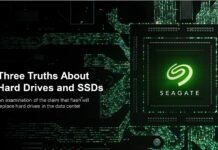DDN, the veteran high performance computing storage vendor that recently bought several enterprise storage businesses, has had a makeover.
Here is its new logo:

And this is what the company has to say about the new logo.
“DDN’s new circular segmented logo symbolizes the company’s new energy and reflects its path of continuous innovation and renewal. A bright and vibrant new color scheme pays tribute to its legacy and modernizes the brand to underscore the company’s dedication to its customers and the desire to combine the best technologies with dynamic expertise to deliver a streamlined experience with deeper more valuable insight into their data assets.”
So there you have it, but why did the company go to the bother of a rebrand? DDN has emerged from a flurry of acquisitions to become an enterprise and HPC vendor covering containers, virtual systems, files, blocks, objects, and software-defined storage.
The acquisitions are:
- Lustre organisation from Intel in June 2018,
- Tintri array for virtual servers September 2018
- Nexenta SW-defined file and object storage in May 2019
- IntelliFlash organisation from Western Digital in September 2019
Bulked-up DDN says it has 10,000 customers and is the largest privately-held storage supplier, with 20 technology centres around the globe. The company has assimilated the acquisitions into DDN and Tintri business units and is now pitching itself a provider of “Intelligent Infrastructure”. It can provide storage to enterprise and HPC customers and support on-premises, public cloud and hybrid cloud use.
DDN offers classic storage for HPC, which is basically parallelised data access to vast data file stores. HPC-style IT has been adopted by enterprises for big data analytics and the AI/machine learning world.
Tintri’s patch – legacy on-premises enterprise IT – is evolving too, with virtualised servers meeting a wave of containerisation and Kubernetes orchestration and a widening adoption of software-defined storage to avoid hardware supplier lock-in. That storage in general is unifying some or all of block, file and object access to simplify the storage infrastructure, and adopting a predictive analytics-style management facility delivered as a service.
The on-premises world is butting up against public cloud and reacting with hybrid clouds combining on-premises and public cloud IT facilities and consumed with public cloud-like on-demand scalability and subscription payment schemes.

Behold the new DDN, which says HPC-like workflows in the enterprise market, driven by AI and huge analytics, are moving IT organisations to embrace parallel file systems and scalable data management platforms.
Sure, storage demand is growing, but DDN is now competing with the mainstream storage array vendors (Dell, HPE, NetApp, Pure, etc.), filer and object storage suppliers (Isilon, Qumulo, Cloudian, Scality, etc.), and HPC businesses such as Panasas, as well as new technology startups (Infinidat, StorONE, VAST Data, Weka, etc.)
DDN’s HPC market strength gave it the financial firepower to make the four acquisitions. Can it parlay this into general enterprise IT market success against such a widespread array of deep-pocketed and new, VC-funded technology suppliers? Let’s hope it does because that will spur them to do better too.








